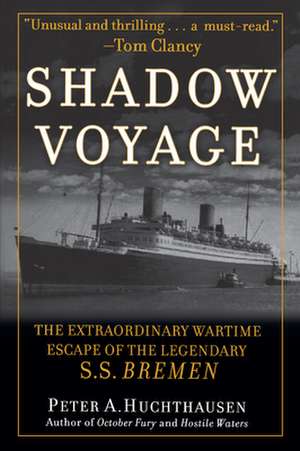Shadow Voyage: The Extraordinary Wartime Escape of the Legendary SS Bremen
Autor Peter A. Huchthausenen Limba Engleză Hardback – 7 apr 2005
On the sweltering evening of August 30, 1939, the German luxury liner S.S. Bremen slipped her moorings on Manhattan′s west side, abandoned all caution (including foghorns, radar, and running lights), and sailed out of New York Harbor, commencing a dramatic escape run that would challenge the rules for unrestricted warfare at sea. Written by naval historian Peter Huchthausen, Shadow Voyage tells the epic adventure of the Bremen′s extraordinary flight to Germany, which became a life–and–death race with British warships and submarines intent on intercepting her. Revealing new details from naval archives, Huchthausen′s riveting narrative captures the great courage and magnanimity of the Royal Navy, the cunning and intricate planning of the Germans, and the tension and ambiguity that preceded the outbreak of World War II.
Captain Peter Huchthausen, U.S. Navy, Retired (Hiram, ME), has had a distinguished career, serving at sea and on land as a Soviet naval analyst and as a naval attaché in Yugoslavia, Romania, and the Soviet Union. He is now a consultant and writer, author of the bestselling Hostile Waters and October Fury (0–471–41534–0).
Preț: 202.16 lei
Nou
Puncte Express: 303
Preț estimativ în valută:
38.69€ • 40.34$ • 32.15£
38.69€ • 40.34$ • 32.15£
Carte disponibilă
Livrare economică 27 februarie-13 martie
Preluare comenzi: 021 569.72.76
Specificații
ISBN-13: 9780471457589
ISBN-10: 0471457582
Pagini: 260
Dimensiuni: 164 x 237 x 24 mm
Greutate: 0.52 kg
Editura: Wiley
Locul publicării:Hoboken, United States
ISBN-10: 0471457582
Pagini: 260
Dimensiuni: 164 x 237 x 24 mm
Greutate: 0.52 kg
Editura: Wiley
Locul publicării:Hoboken, United States
Public țintă
WW II buffs, naval history and submarine readers, sailors; public libraries, naval historical sites.Cuprins
Acknowledgments. Prelude.
Introduction.
1. Uncertain Crossing.
2. Roosevelt s Neutrality.
3. Obfuscation and Delay.
4. Into Oblivion.
5. Running North.
6. Close Encounters.
7. Running for Refuge.
8. Soviet Support.
9. Plotting Escape.
10. Salmon Bags a U–Boat.
11. Running for Home.
12. Salmon s Dilemma Bremen s Escape.
13. Cheers and Retribution.
Afterword.
Notes.
Bibliography.
Index.
Introduction.
1. Uncertain Crossing.
2. Roosevelt s Neutrality.
3. Obfuscation and Delay.
4. Into Oblivion.
5. Running North.
6. Close Encounters.
7. Running for Refuge.
8. Soviet Support.
9. Plotting Escape.
10. Salmon Bags a U–Boat.
11. Running for Home.
12. Salmon s Dilemma Bremen s Escape.
13. Cheers and Retribution.
Afterword.
Notes.
Bibliography.
Index.
Recenzii
On August 30, 1939, the 52,000–ton Nazi passenger ship Bremen stole out of New York harbor, cleared Sandy Hook, shut out its lights, and veered north toward Greenland, using bad weather as a shield against what would become many pursuers. For the British to gain the Bremen would be a propaganda victory, but, more important, its seizure would also provide the Royal Navy with a much–needed troop transport ship, the eventual use the Kriegsmarine put it to. The Bremen therefore steered an elaborate evasive course that took it far into arctic waters and to Murmansk, Russia, a friendly port by virtue of the Nazi–Soviet nonaggression pact. From there it steamed to Germany, evading a British vessel that did not fire upon her, it appears, for humanitarian reasons, inasmuch as warships were not then supposed to sink passenger ships. By the time the Salmon found the Bremen, Germany was no longer observing such niceties, a fact by which Britain scored propaganda points and claimed moral victory in the engagement. Huchthausen′s recounting of the Bremen′s tortuous, 14–week journey has its Hunt for Red October moments, but the drama is sometimes blunted by too much detail, swallowing the highlights. Huchthausen also shares Tom Clancy′s fascination with technical arcana; along the way, for instance, he explains why the shape of the Bremen, both long and broad, and its use of the "bulbous forefoot" ("This protrusion makes a hole in the water as the ship plows ahead, forcing seawater away to both sides and downward, thereby reducing drag on the skin of the shop, increasing the mass of the water at the stern, and strengthening the bite against which the propellers can thrust") were factors in its escape.
A solid bit of maritime history, ably recounting a mere footnote but an interesting one to the larger Battle of the Atlantic. (Kirkus Reviews, February 1, 2005)
"A solid bit of maritime history...an interesting one." (Kirkus Reviews, February 1, 2005)
A solid bit of maritime history, ably recounting a mere footnote but an interesting one to the larger Battle of the Atlantic. (Kirkus Reviews, February 1, 2005)
"A solid bit of maritime history...an interesting one." (Kirkus Reviews, February 1, 2005)
Descriere
On the sweltering evening of August 30, 1939, the German luxury liner S.S. Bremen slipped her moorings on Manhattan′s west side, abandoned all caution (including foghorns, radar, and running lights), and sailed out of New York Harbor, commencing a dramatic escape run that would challenge the rules for unrestricted warfare at sea.









